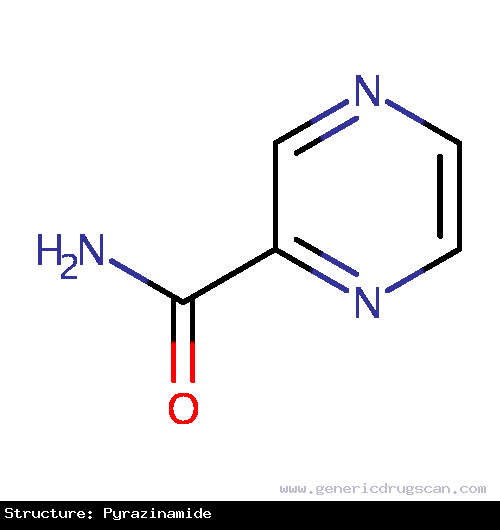Pyrazinamide Drug: Indication, Dosage, Precaution, Side Effect , Storage, Category Type and corresponding Brands - www.genericdrugscan.com
Pyrazinamide
Drug Status in USA : ApprovedDrug Status in Canada : Approved
pronunciation
pronounced as (peer a zin' a mide)
Why is this medication prescribed?
Pyrazinamide kills or stops the growth of certain bacteria that cause tuberculosis (TB). It is used with other drugs to treat tuberculosis.
This medication is sometimes prescribed for other uses; ask your doctor or pharmacist for more information.
How should this medicine be used?
Pyrazinamide comes as a tablet to take by mouth. It usually is taken once a day (at the same time each day) or in larger doses twice a week. Pyrazinamide may be taken with or without food. Follow the directions on your prescription label carefully, and ask your pharmacist or doctor to explain any part you do not understand. Take pyrazinamide exactly as directed. Do not take more or less of it or take it more often than prescribed by your doctor.
What are the precautions to be followed?
Before taking pyrazinamide,- tell your doctor and pharmacist if you are allergic to pyrazinamide, niacin, ethionamide (Trecator-SC), or any other drugs.
- tell your doctor and pharmacist what prescription and nonprescription medications you are taking, especially allopurinol (Zyloprim), colchicine and/or probenecid (Col-Probenecid, Benemid), ethionamide (Trecator-SC), and vitamins.
- tell your doctor if you have or have ever had gout, liver or kidney disease, or diabetes.
- tell your doctor if you are pregnant, plan to become pregnant, or are breast-feeding. If you become pregnant while taking pyrazinamide, call your doctor.
- plan to avoid unnecessary or prolonged exposure to sunlight and to wear protective clothing, sunglasses, and sunscreen. Pyrazinamide may make your skin sensitive to sunlight.
What are possible side effects of this medication ?
Pyrazinamide may cause side effects. Tell your doctor if any of these symptoms are severe or do not go away:- upset stomach
- fatigue
- skin rash
- fever
- vomiting
- loss of appetite
- yellowing of the skin or eyes
- darkened urine
- pain and swelling in the joints
- unusual bleeding or bruising
- difficult urination
How to store the medication and dispose it of after its use later?
Keep this medication in the container it came in, tightly closed, and out of reach of children. Store it at room temperature and away from excess heat and moisture (not in the bathroom). Throw away any medication that is outdated or no longer needed. Talk to your pharmacist about the proper disposal of your medication.
Drug Category/Class
- Antitubercular Agents
- Antimycobacterials
- Drugs for Treatment of Tuberculosis
- Cytochrome P-450 CYP1A2 Inhibitors
- Cytochrome P-450 CYP1A2 Inducers
- Antiinfectives for Systemic Use
- CYP3A4 Inhibitors
- Other drugs for treatment of tuberculosis
- Combinations of drugs for treatment of tuberculosis
| Prescribed | For the initial treatment of active tuberculosis in adults and children when combined with other antituberculous agents. |
| Weight : | 123.1127 |
| Structure | Pyrazinamide |
 | |
| Formula | C5H5N3O |
Pyrazinamide has 100 Brands listed
Search Generic Drugs alphabetically
